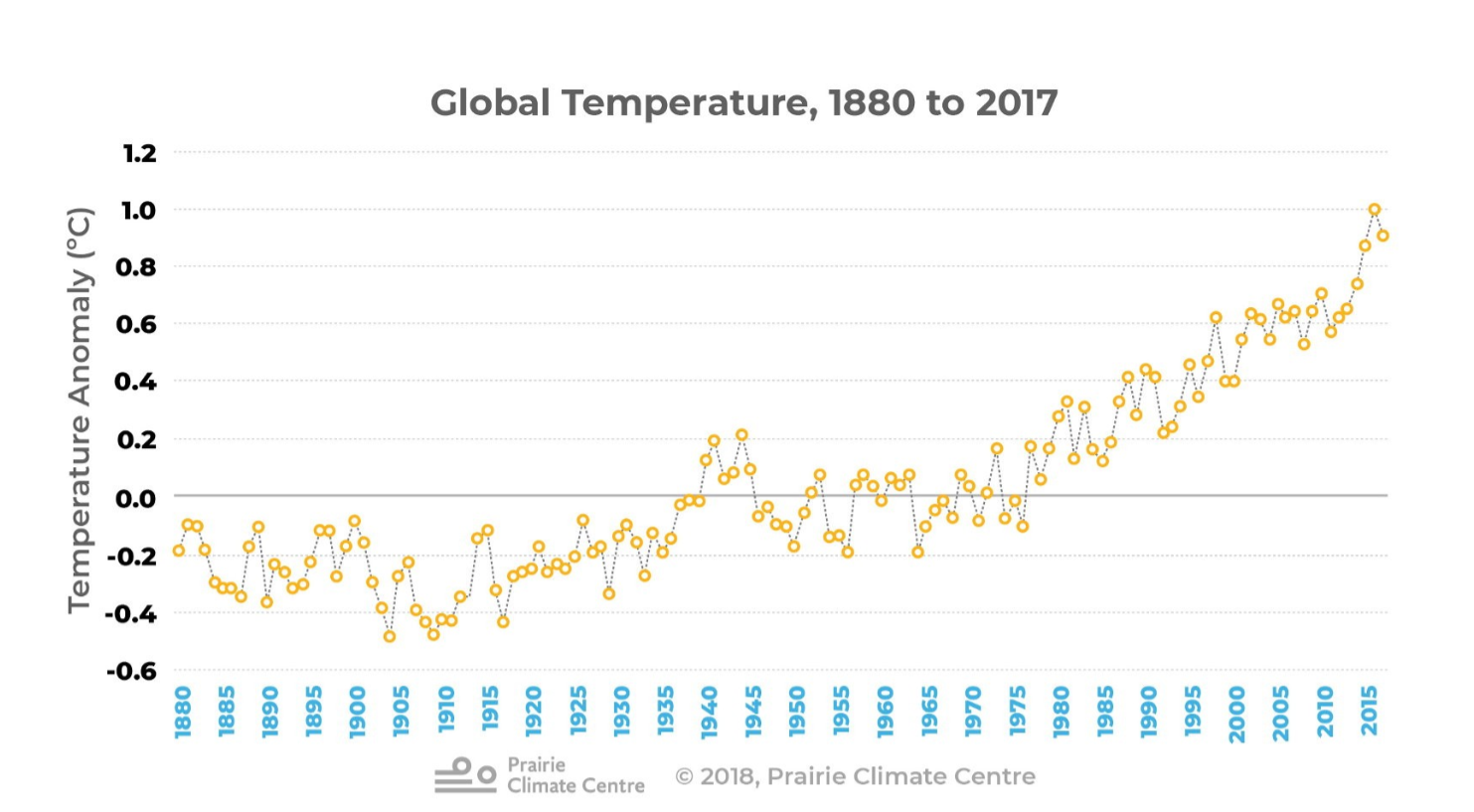Have you ever been to a family function or a work lunch and suddenly found yourself stuck in a conversation with someone about greenhouse gases, melting glaciers, and crazy tropical storms? When climate change comes up, it’s sometimes difficult to know what to say, and it can feel awkward to ask questions about something that everyone seems to have an opinion about. It’s not like you don’t know what climate change is; we hear about it all the time! But it’s such an overwhelming issue and, let’s be honest, many technical terms and data are being thrown around that can give you a headache! So, I set out to answer: “What is climate change?”
First off, we need to clarify what climate is. Essentially, climate is the usual weather of any given place. Your city might have different climates for different seasons (like hot and dry in the summer, and cold and wet in the winter). But climates aren’t just limited to Cities or Regions. The Earth itself has a climate (I know, cool right?!).
Climate change refers to a long-term shift in the typical weather patterns in a specific location. This could be a change in the amount of precipitation or temperature for a month or year. Climate change is also a change in Earth's climate. Climate change involves both changes in average conditions and variability, including extreme events. [1][2]
Okay, now you’re probably thinking, “Hold up! Isn’t the Earth’s climate always changing?” and you’re exactly right! There have been times when the Earth has been warmer than it is now, and colder than it is now, and these periods of different climates can last millions of years (think about the Ice Ages!).
Scientists who study the Earth say there are natural fluctuations in the Earth’s climate. Numerous factors cause climate change. These could include natural reasons, including the Earth's tilt, its orbit around the sun, large volcanic eruptions, and changing ocean currents.. So, why are we concerned about the Earth’s changing climate, if this is a natural phenomenon and has occurred before? [3]
Well, it turns out that the changing climate that the Earth is experiencing now is not like those periods of climate change that have happened in the past. Those scientists who study the Earth’s fluctuating climate, say that the Earth’s temperature is rising faster than it has at any other time on record. [4]

Check out this graph above from the Climate Atlas. It shows the Earth’s temperature from 1880 to 2017 (anyone else scared by that upward trend?). This graph shows us that 17 of the 18 warmest years on record have occurred since 2001, yikes!
So why exactly are temperatures rising so quickly in more recent years? If you’re thinking “humans, duh!” then you’re right, but did you know that it's due to the greenhouse gases that humans are putting into the atmosphere?
Hold up, what are greenhouse gases?
Greenhouse gases are a bunch of different gases that act like insulation for the Earth. Imagine that the Earth is wearing an invisible sweater that traps heat to keep the planet warm. This is called the greenhouse effect. The greenhouse effect is the natural warming of the Earth when gases trap heat in the atmosphere. It is a balanced system. Because of humans, a build-up of extensive amounts of greenhouse gases in the atmosphere has led to an enhancement of the natural greenhouse effect, making it unbalanced.
Due in large part to this greenhouse effect, the world today is nearly 1˚C (1.8˚F) warmer than it was before the Industrial Revolution. [6]
Well... the Earth wearing a big, cozy sweater doesn’t sound so bad does it?
Greenhouse gases aren’t all bad; they keep the planet warm enough for us to live on it. And for a long time, the amount of greenhouse gases in our atmosphere was pretty stable, so the Earth’s overall temperature remained stable too. So, what’s the problem?
The problem with the greenhouse effect is that human activities, like driving cars and using electricity, put more greenhouse gases into the air. This causes the Earth to heat up, and this is why we are seeing such a dramatic rise in the Earth’s temperature. Remember that sweater analogy? Well, it’s as if every time humans do something that releases greenhouse gases into the air, the sweater becomes thicker, keeping the planet even warmer!
The United Nations’ Intergovernmental Panel on Climate Change (IPCC) reports that Earth’s average surface temperature has increased by roughly 1°C since the Industrial Revolution, alongside the rise in carbon dioxide emissions.
Most of the warming occurred in the past 35 years, with the six warmest years on record taking place since 2014... (and so on).
Now, coming back to our original question (finally!) The climate change we are experiencing today is the warming of the Earth’s climate caused by increased greenhouse gas emissions from human activity. Human activities, such as the burning of fossil fuels (oil, natural gas, and coal) and the conversion of land for forestry and agriculture, release GHGs, which trap heat in the atmosphere. The gases then slowly release heat energy that warms the planet and can alter things like wind circulation patterns and the movement of clouds, which also affects precipitation.
The accumulation of greenhouse gases is altering Earth's energy balance and contributing significantly to climate disruption.
Sources:
- (https://www.epa.gov/climatechange-science/frequently-asked-questions-about-climate-change
- https://www.bbc.com/news/science-environment-24021772
- https://en.wikipedia.org/wiki/Climate_variability_and_change
- https://davidsuzuki.org/what-you-can-do/what-is-climate-change/
- https://climateatlas.ca/climate-change-basics
- https://www.c2es.org/content/changes-in-climate/
%20(4).png)

